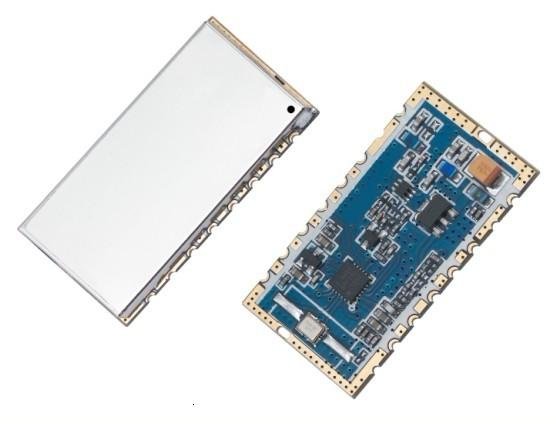It is a new module from a company called "Nice RF" . This is different to HopeRF , so it seems that competition is alive and well in Shenzhen, China!
The module is the RF4463F30 .
Now HopeRF have a similar module , the RFM23BP, based on the Si4463's predecessor, the Si4432. This module can be purchased for around $9USD from places such as Anarduino
Remember, the Si4432 is the IC inside the venerable RFM22B, as used in $50Sat, which has now been continuously operating in space for more than 6 months! While the RFM22B has an output of +20dBm, the RFM23BP has an output of +30dBm. The RFM23BP also requires a 5V supply ( but supposedly works down to 3.3V)
To work out the differences between the RFM23BP and the RF4463F30, we'll need to dig into the datasheets. Now at the moment, the datasheet for the RF4463F30 is a little sparse, so I'll have to wait til my in-depth queries are answered by their tech support people. But on the surface, the differences are as follows:
Max Data Rate: 256kbps (RFM23BP), 1000kbps (RF4463F30)
Receive mode sensitivity: -120dBm (RFM23BP), -126dBm(RF4463F30)
Note the higher sensitivity of the RF4463F30 is based on a lower bit rate and smaller frequency deviation.
Receive mode current: 25mA (RFM23BP), 10-13.5mA (RF4463F30) - which seems to have 2 different sensitivity modes - High and Low
Transmit mode current (max power): 550mA (RFM23BP), 540mA (RF4463F30)
Size: 33mmx18mm(RFM23BP), 38mmx20mm(RF4463F30)
Now as the RF4463F30 is based on the Si4463, all the software commands that apply to the Si4463 can be used on the RF4463F30. Bearing in mind that 2 of the GPIO pins are used internally in the module for antenna switching functions.
So is this new module worth double the cost of the RFM23BP? Remembering we're talking about wireless modules that cost under $20 each, but it depends on your scenario. If you need to have (relatively) high power, both modules fit the bill, with similar power output and power usage. The newcomer seems to use less on the receive side, but if you want lower power usage for receiving, you may want to get the regular Si4463 module without the high power option, as the sensitivity is the same. The HopeRF module uses a register based firmware, whereas the Si4463 uses a new API approach.
I think some testing may be in order to really understand how the modules perform.
Other Modules
Looking at the NiceRF website, they have a few other modules that use either the Si4432 or the Si4463 Wireless IC's. Another of interest is the RF4432F27 . Looks like a +27dBm version of the RFM22B. Max TX current is 350mA @ 5V ( in case 500mA is too high)
They also have some test or demo boards with built-in Microcontroller and LCD.
All in all, it looks like there are now a few more options for ready made radio modules for PocketQube's!
